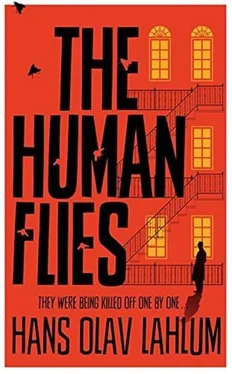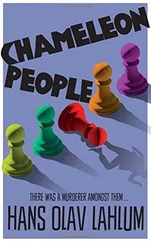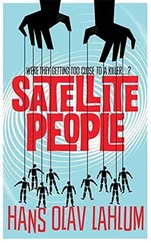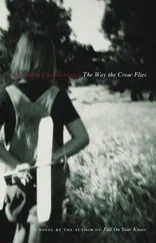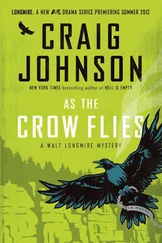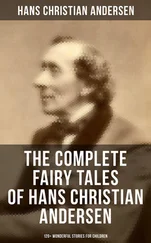From half past eleven all available police officers helped to search the flats and building from top to bottom, without finding the weapon or anything else that might help to clear up the murder mystery. The caretaker’s wife had been given four hours’ pay to clean the victim’s flat the previous weekend and had used her time diligently. With the exception of her own fingerprints, the only ones found in the flat were those of Harald Olesen.
Meanwhile, I pondered the possibility that the murderer had actually never been in the flat, but had fired the shot from another building. This theory was, however, flawed, as it would appear that Harald Olesen had been sitting or standing in front of a solid stone wall without a window when the shot was fired. And if that did not make things difficult enough, all the windows in the room were still intact.
So, apart from the presence of a dead man with a bullet wound in his chest and the bullet lodged in the wall behind him, there was no sign of drama in the flat. Harald Olesen was lying on the floor in the sitting room by a coffee table that was set for two. He had drunk from one cup and left his fingerprints on it, whereas the cup on the other side of the table was untouched. It would appear that Harald Olesen had been expecting someone for coffee and cake, but there was nothing to say who had visited him – or whether the invited guest was the murderer.
The remains of a meal of meatballs were still standing on the cooker and by the sink. There was milk, bread and cheese in the fridge for tomorrow morning’s breakfast. The radio on the kitchen table was plugged in. A Vienna Philharmonic Orchestra record lay ready on the turntable. Death had obviously come suddenly to Flat 3A in 25 Krebs’ Street.
By one o’clock on the morning of 5 April 1968, it was clear to me that there was nothing more to be gained from staying at the scene of the crime. I left one constable on guard on the second floor and another on the street outside the building. I asked the pathologist to send me a report as soon as possible, and requested copies from the census records and police records for all the residents of 25 Krebs’ Street. Then I sent everyone there to bed, but asked that they stay at home in the morning to be available for questioning.
It was already clear to me on the night of the murder that the murderer was in all likelihood one of the deceased’s neighbours. There was nothing to indicate so far that anyone else had been in the building that evening. Fortunately, I had no idea how difficult it was going to be to find out which flat the murderer had come from.
DAY TWO: Seven Neighbours – and a Blue Raincoat With No Owner
I got up unusually early on Friday, 5 April 1968. By half past six I was seated at the breakfast table engaged in a fascinating discussion with my reflection in the coffee pot. We promptly agreed that this was a case I should not allow to be taken from me by the more senior detectives. They could be trusted to give me all the dull tasks, while they themselves took all the glory for solving the case. Fortunately, my boss usually came to work before them. And on that day, I even beat him to it. When he unlocked his office at the main police station in Oslo at a quarter to eight, I was already sitting ready in the corridor.
The commanding officer was a broad-minded man in his sixties who understood that it was important to encourage hard-working young men with inflated ambitions. He had, in fact, mentioned on several festive occasions that he himself had been just such an overambitious young fellow until his fiftieth birthday. It was therefore no surprise that he now found my enthusiasm and interest in the case to be praiseworthy. He agreed that it was certainly of no disadvantage that I had been the first inspector at the scene. And by the time the clock struck eight we had shaken hands and agreed that I would lead the investigation on my own and that the scope of my authorities would be extended in order to do so. I nodded hastily that I would of course seek advice from him and other more experienced colleagues should it be necessary. Then I strode confidently into my first murder investigation, intoxicated by the belief that it would bring me both honour and glory.
The Friday papers had little to report regarding the murder in 25 Krebs’ Street. Two of them carried a small notice about the murder, and one hinted, without mentioning any names, that the deceased was ‘a well-known and highly respected citizen with a background in the Resistance movement’. During my brief pit stop at 19 Møller Street that morning, the switchboard could already confirm that the media’s interest in the case was growing rapidly. Before leaving for Krebs’ Street, I therefore dashed out a short press release. First and foremost, it stated clearly that I had been given overall responsibility for the murder investigation. In addition, the press release confirmed that it was former cabinet minister and Resistance fighter Harald Olesen who had been shot and killed in his home in Krebs’ Street on the evening of 4 April, but in light of the ongoing investigation no further comment would be forthcoming.
On my arrival at the scene of the crime on the morning of 5 April, I began at the obvious starting point: a tidy little caretaker’s table just inside the front entrance. The caretaker’s wife who sat there was called Randi Hansen and was a small, plump, grey-haired woman in her early sixties. She lived in the caretaker’s one-bedroom flat in the basement. Her husband normally worked there as the caretaker, but, she informed me, was away that week. Their children had moved out many years ago, so she generally sat alone at her post in the entrance, a few steps down from the flats on the ground floor. She looked after 25 and 27 Krebs’ Street, alternating between the two, as well as managing all telephone calls to and from both buildings. As fortune would have it, she had been sitting in 25 Krebs’ Street on 4 April. She promised to stay at her post until the investigation had been closed.
Randi Hansen proved to be an exceptionally diligent individual who had noted everyone’s comings and goings that afternoon and evening. As with most caretakers’ wives, she knew the residents and their daily routines relatively well.
The caretaker’s wife was careful to point out that she only sat in this building every other day and that sometimes she was ill or had to leave her post for a few hours. However, she believed that her impressions of the residents and their activities were fairly accurate. I saw no reason to doubt this, but immediately noted that there was a 50 per cent chance that any visitors or incidents might pass unnoticed. Furthermore, from her position by the entrance it was not possible to see the doors to the flats or the hallway, even on the ground floor.
The murder victim, Harald Olesen, had lived on the second floor since before the war. As a cabinet minister, he had been one of the most famous people in this part of town and the pride of the street. In his later years, he had lived the quiet life of a pensioner, but still came and went with some irregularity. The caretaker’s wife had seen him together with many a national politician and well-known Resistance fighter over the years, but less often more recently. Visits from his relatives were also less frequent since his wife’s death five years ago. The caretaker’s wife thought that he had found it very hard to accept that he was a widower, despite outward appearances. With the exception of shopping trips to the Co-op on the corner, Olesen had started to go out less and less. He was a friendly and correct man who always greeted her with a nod as he passed. If he had laundry to be done, or required any other extra service, he always asked politely and paid well. The caretaker’s wife had never noticed any tension between him and the other residents. In fact, she found it hard to imagine who on earth would want to kill such a kind and respected pillar of the community.
Читать дальше
